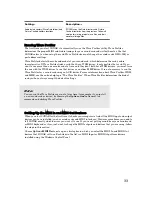
27
Engl
ish
synchronizing audio or MIDI to film or video. Or, you can turn chase lock off to conserve CPU power.
SONAR provides high-quality time stretching and sample-accurate editing with zero-crossing
detection so you can make the fine adjustments you need in record time. In addition, SONAR’s support
for video files gives you convenient synchronized access to digitized video, making film and video
scoring easier than ever.
Flexibility
SONAR works the way you want to work—you can customize screen layouts, toolbars, and audio and
MIDI system configurations to make your work more efficient. SONAR integrates with other sound
editing tools so you can access them in an instant without leaving SONAR.
Computers, Sound, and Music
This section provides some background on the different ways that computers store and play sound and
music. Computers work with sound and music in two different forms:
MIDI
and
digital audio
.
MIDI
MIDI (short for Musical Instrument Digital Interface) is the way computers communicate with most
sound cards, keyboards, and other electronic instruments. MIDI refers to both the type of cables and
plugs used to connect the computers and instruments, and to the language those computers and
instruments use to talk to each other. The MIDI standard is accepted and used worldwide. Almost any
electronic instrument you buy today will have MIDI connectors and can be used with other MIDI
instruments and with your computer’s MIDI interface.
The MIDI language conveys information and instructions, both from the computer to the instrument
and from the instrument to the computer. For example, if your computer wants your keyboard to play a
note, it sends a MIDI “Note On” message and tells the keyboard which note to play. When your
computer wants the keyboard to stop playing that note, it sends another message that stops the note
from playing.
The MIDI language has many other instructions, such as messages to change the sound that is used to
play the notes (the bank and patch), messages used to work the sustain pedal and the pitch-bend wheel,
and others. By sending the right messages at the right times, your computer can control your electronic
instrument and make it play music.
MIDI information can be sent on 16 different channels. You can set up your MIDI equipment to listen
for messages on all channels or on only a few.
MIDI files contain all the MIDI messages and timing information that are needed to play a song. MIDI
files can be read and played by many different programs, including SONAR, and can even be played by
programs on other types of computers. MIDI files have the extension .
MID
.
There are several important advantages of the MIDI format:
•
Large amounts of music can be stored in a very compact form
•
Different parts of a piece can easily be assigned to any instrument you can imagine
•
The music contains information on notes, tempos, and key signatures that makes it possible to
display and edit the piece using standard musical notation
The primary disadvantage of MIDI is that the quality of the music a listener hears will vary depending
on the MIDI equipment the listener is using. For example, MIDI usually sounds much better on an
expensive synthesizer than it does on an inexpensive sound card.
Summary of Contents for Cakewalk SONAR
Page 1: ...Cakewalk SONAR User s Guide ...
Page 2: ......
Page 4: ......
Page 22: ...xxii ...
Page 50: ...50 ...
Page 102: ...102 ...
Page 182: ...182 ...
Page 302: ...302 ...
Page 420: ...420 English ...
Page 466: ...466 ...
Page 502: ...502 ...
Page 574: ...574 ...
Page 580: ...580 ...
Page 608: ...608 ...






























